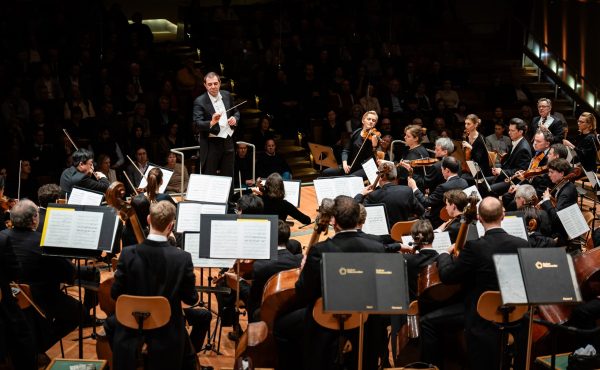 Germany Schoenberg, R. Strauss, Wagner: Berlin Philharmonic Orchestra / Daniele Gatti (conductor). Philharmonie Berlin, 2.2.2024. (MB)
Germany Schoenberg, R. Strauss, Wagner: Berlin Philharmonic Orchestra / Daniele Gatti (conductor). Philharmonie Berlin, 2.2.2024. (MB)

Schoenberg – Verklärte Nacht, Op.4 (1943 version for string orchestra)
R. Strauss – Tod und Verklärung, Op.24
Wagner – Tristan und Isolde: Prelude to Act I and Liebestod
Repertoire, orchestra, and conductor: a marriage made in heaven — or, if we are to be Nietzschean about it, in the ‘voluptuousness of hell’ with which he diagnosed Wagner’s Tristan und Isolde. In this cleverly devised programme, Daniele Gatti and the Berlin Philharmonic took us through three works of explicit transfiguration, that transfiguration, transcendence, or whatever we want to call it in each case following something darker, more malign, more voluptuous and yes, both heavenly and hellish — or, as Nietzsche would have it, beyond good and evil.
The Berliners followed their outstanding Schoenberg programme (review click here) of the previous week, under Kirill Petrenko, with a Verklärte Nacht of equal distinction. I often have my doubts about the version for string orchestra – what does it actually add to the original string sextet writing? – but not here, not for a second. What it was to hear massed Berlin strings, superbly led by Vineta Sareika-Völkner, in this music: the tremolo of seven double basses, or the unanimity of violas in pizzicato, and unisons to put the fear of God into Bruckner. The dark allure of its opening, taken a little slower than usual and all the better for it in Gatti’s particular conception, attested to a veritable symphonic poem. Flexibility was such that one did not notice it, all part of a greater, coherent whole, heard – like all the music on this programme – as if in a single, infinitely variegated breath. Violence was unsettlingly sweet; transfiguration, when it came, never without shades of something darker. For all its tonal insistence, relatively speaking, there were spellbinding passages that took us to liminal places of near-suspension. And, for once, we heard a true outpouring of love, abundant, fulfilling, even overflowing, once the figurative tide had turned. It seemed to prefigure, perhaps even to ‘correct’, as Wagner attempted with Schopenhauer, its fons et origo in Tristan. There was rhetorical eloquence too, but never did it come into conflict with form and structure. Post-Wagnerian narrative, be it musical or extra-musical, seared its way into our consciousness, albeit with all the chamber-music motivic rigour of a composer devoted with equal ferocity to the legacy of Brahms.
Another dark opening announced Tod und Verklärung: one noticed and felt, in its heartbeat hesitations both similarity and difference vis-à-vis Verklärte Nacht. It was immediately clear that this was a more tonally stable world; there was no question here of losing aural sight of those tonal moorings, even as the soul departed for wherever it was going (or not). The excellence of the Berlin strings was now added to by woodwind and eventually others, the orchestra once more at the very top of its game. I should be listing the entire orchestra were I to name every instance, but special mention should go to the solo flute, oboe, English horn, and of course to Sareika-Völkner as leader. Clarity and purpose in musical narrative were second to none in Gatti’s reading, that there was simply no need to ask the old question about the importance (or not) of the programme. The work’s complex form – the more so the more one truly listens, just as in Beethoven – was brought to life unerringly, moving and thrilling in equal measure in a performance that had one feel one was hearing this music for the first time. The radiance of the conclusion proved every inch worth of comparison to that of Schoenberg’s piece.

As it did to that of the Tristan excerpts. Again, I often have my doubts about the wisdom of pairing the first-act Prelude to the so-called Liebestod; again, such was the conviction of this performance that such doubts never arose, and not only because Liszt’s description is better jettisoned for Wagner’s own: Isoldes Verklärung. The intensity of the Prelude had to be heard to be believed, vibrato but a single example of its expressive richness at a dramatic temperature at least equal to that of Karl Böhm, albeit in less of a hurry. Not only did the music unfolded as if in a single breath; it offered testament to Schopenhauer’s one, all-pervasive Will, of which it stands as the closest and dearest representation. The Prelude’s inability or unwillingness to close was so apparent that it seemed, for once, a natural move to expunge its pantonal presentiments through Isolde’s transfiguration. That second part flowed as if against the most inviting of tides, until enveloped by them. ‘Sind es Wellen sanfter Lüfte?’ Why choose? This was a miraculous lightness of being – and non-being – unbearable, doubtless, were it forever, yet for the moment exquisite and necessary beyond words. I have yet to hear Gatti conduct Wagner’s drama in the theatre, but on this evidence it would be a Tristan to rival those of Barenboim and Kleiber—and his own Bayreuth Parsifal.
Mark Berry
